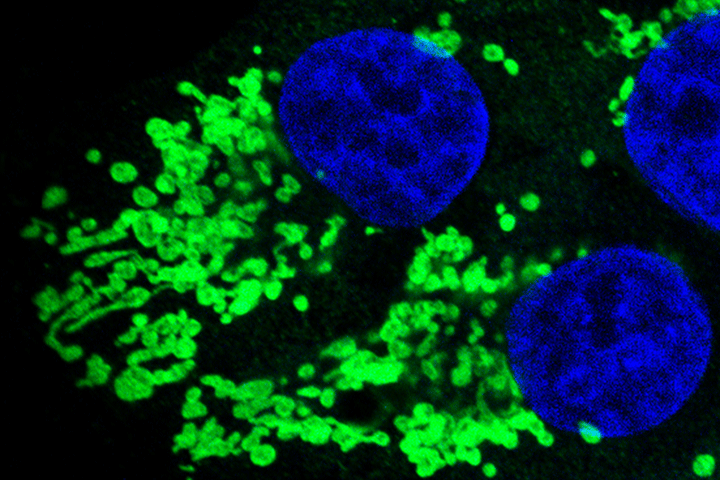Putting the Immune System on the Offensive

Daniel Sone; National Cancer Institute
Teaching the immune system to attack pancreatic cancer could be the key to finding a cure.
Ever thought about what goes on in our bodies when we’re fighting the flu?
Imagine a flurry of activity beneath the skin, a legion of immune cells scurrying here and there, united against the infection. With expert coordination, the cells divide and conquer, identifying invaders, gobbling them up, and clearing the remains away. Every enemy is recorded, each battle, memorized. That way, the next time we catch the flu (or one of its nasty relatives), our immune system knows exactly what to do.
Since the invention of the first vaccine in 1797, doctors have marveled at the curative power of our immune system.
Now, researchers are discovering new ways to harness that power against pancreatic cancer, sending patients into long-lasting periods of remission and changing the face of pancreatic cancer treatment as we know it.
Releasing the Immune System’s Brakes
Cancer immunotherapies harness our bodies’ natural defenses in different ways. Some, as the American Cancer Society sums up nicely, stimulate the immune system “to work harder or smarter to attack cancer cells,” leveraging existing immune cells to do the job. Other treatments introduce man-made proteins into the body that mimic components of our immune system, or help with delivery of radiation or chemotherapy.
Some of the most buzzed-about immunotherapies of the moment are checkpoint inhibitors, monoclonal antibodies that take the brakes off the immune system to let it respond more powerfully to malignancies.
Checkpoints play an integral role in the immune system by helping immune cells differentiate healthy cells from invaders. Without them, immune cells wouldn’t know which cells to target and which to leave alone.
Cancer cells, however, are wily. They know how to turn on checkpoints, throw up stop signals and engage the immune system’s brakes.
By working on T cells, an important type of immune cell, checkpoint inhibitors can release those brakes. With the brakes off, immune cells can see the cancer cells for what they are—enemy invaders—and dispense with them.
Checkpoint inhibitors work best in tumors that naturally induce a T cell response. Some cancers trigger a more pronounced response than others; in melanoma, for example, T cells are abundant, one of the reasons why melanoma responds so well to checkpoint inhibitors.
But in other cancers, including pancreatic cancer, T cells are scarce. Without enough T cells to work on, checkpoint inhibitors can’t kill tumors on their own.
Researchers now know that to capitalize on checkpoint inhibitors, they’ve got to get T cells into pancreatic tumors first. Only then can checkpoint inhibitors do their job.
“Checkpoint inhibitors are game-changers,” explains Elizabeth Jaffee, M.D., deputy director of the The Sidney Kimmel Comprehensive Cancer Center at Johns Hopkins Medical Center and a co-leader of the Stand Up To Cancer-Lustgarten Foundation Pancreatic Cancer Convergence Dream Team, “but they only work in patients who already have T cells infiltrating their cancers. Pancreatic cancers lack this initial immune activation, so first we have to induce the T cells to enter the tumors.”
There are several ways to do this (and this is a big research focus)—though Jaffee’s work revolves around a special cancer vaccine she helped invent, GVAX Pancreas, which lures T cells to pancreatic cancer cells and gets the process started. Once the T cells get into the tumors, checkpoint inhibitors—such as pembrolizumab (brand name Keytruda) and ipilimumab (brand name Yervoy)—can be layered on to do their work. Using more than one checkpoint inhibitor releases more than one type of brake in the immune system. That’s important, says Jaffee, because “pancreatic cancer is smart.” Pancreatic tumors are endlessly complex, with lots of different types of cells (compared with other cancers) that throw up an array of different stop signals to the immune system. Some stop signals may play more important roles in pancreatic cancer than others. The more researchers learn, the better checkpoint inhibitor therapy for pancreatic cancer will become.
Already, scientists are making progress. “I never thought I’d be able to say this,” says Jaffee, “but we’re seeing regressions in patients with just one (checkpoint inhibitor-CK) combination. In several clinical trials, we’re now testing combinations to see which is best.”
A Personalized Immunotherapy Cure?
Jaffee’s study focus is just one in a research field bursting with innovation.
Scientists at the National Institutes of Health (NIH) are developing other new, personalized strategies to treat solid tumor cancers (like pancreatic) by teaching patients’ immune cells to target their own unique mutations.
In a May 2014 article in the journal Science, NCI chief of surgery and cancer immunotherapy pioneer Steven Rosenberg, M.D., and his colleagues described treating Montana mother of six Melinda Bachini, age 47, for metastasized cholangiocarcinoma, a rare cancer of the bile ducts. By sequencing Bachini’s DNA and pinpointing immune cells in her body specially equipped to target a unique mutation in her cancer, Rosenberg and his team were able to send Bachini into long-lasting remission.
Rosenberg has said that the technique should be translatable to other solid tumor cancers. For the first time “we have been able to actually target a specific mutation in the immune system,” he told NBC News. “It represents a blueprint for how to do this…a new method for potentially attacking any kind of cancer.”
“It’s potentially great,” Jaffee agrees, of the Rosenberg team’s technique.
Undeniably, by one means or another, better immunotherapy treatments for pancreatic cancer seem to be close at hand.
“This is an exciting time,” Jaffee says. “We’re on the verge of an explosion.”





